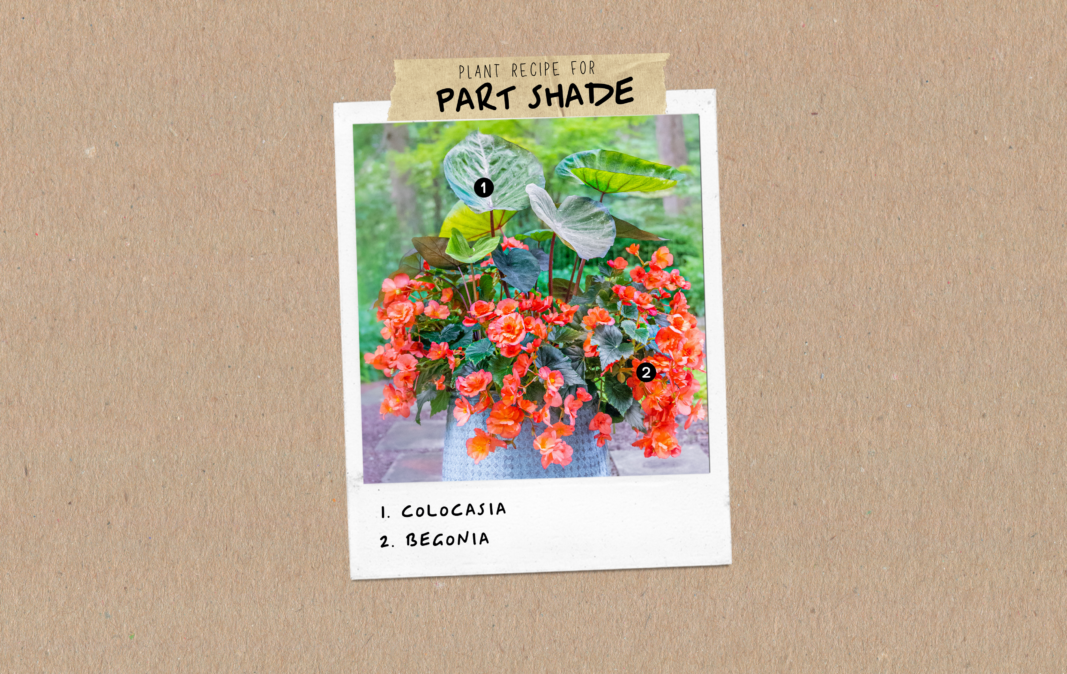 Bryn Wallace
Bryn WallaceBold Begonia Blend Container for Part Shade
This container gives a tropical feel with the large leaves of the colocasia and vibrant orange begonias. It is a big and beautiful addition to the garden, thriving in warm temperatures. The colocasia gives the container height while the orange begonia drapes over the side of the container. It will do well in morning sun and afternoon shade where the leaves will be protected from the heat of the afternoon sun. The colocasia can be brought indoors as a houseplant when the weather gets colder.
Plants Featured
Colocasia
Colocasia, also known as elephant ear, is a perennial bulb with giant leaves that come in lime green, purple or black. This plant can grow indoors all year round, but also looks wonderful out in the garden in containers or amongst other plants in beds and borders in the summer. All parts of this plant are poisonous and may cause skin irritation, so keep it out of reach of pets and kids. Bring this plant inside and use it as a houseplant when temperatures reach below 40 degrees.
Begonia
Begonias can be grown outdoors in containers and come in colors of orange, pink, red, white and yellow. They have hundreds of cultivars to choose from and will bloom from summer to late fall. As an annual, begonias will not come back year after year. Deadheading begonias regularly will encourage more blooms and will keep the plant looking bushy and uniform. Begonias contain calcium oxalate which is mildly toxic and will cause household pets to get sick, so keep it away from cats and dogs.
Planting Instructions
If you’re looking to replicate this container in your own home, follow our step by step potting instructions. Here is an abbreviated version.
1. Select a container. Choose a container with drainage holes. This allows excess water to drain out of the bottom of the pot, letting the roots take in the oxygen they need to survive. When choosing a container, consider the size of the plants you’re planning to put into it. You want to allow plenty of room for root growth. The larger the pot, the more soil you can use, meaning there is more room for growth and it is easier to keep that soil moist.
2. Add Merrifield Potting Mix. We recommend using a well draining potting soil to allow adequate moisture and oxygen balance for optimal plant health. Before you pour in your soil, place a piece of landscape fabric or a coffee filter over the drainage holes in your container. This will prevent soil from leaking out of the holes. Add Merrifield Potting Mix until the container is around ⅔ full.
3. Add a slow release fertilizer. Mix a slow release plant food, such as organic Plant Tone, into the soil. This will provide a continual release of nutrients for your plants to thrive. Follow the instructions on the bag for the amount of fertilizer to add based on the size of your container. Apply it two or three times during the summer.
4. Add your plants. Before placing your plants into the soil, we suggest arranging your plants in their growers pots to see what the layout will look like when they are planted. Then, working with the tallest plant first, colocasia in this instance, remove the growers pot and loosen the roots, tucking the plant into your fertilized soil. Continue planting with the begonia in the same way. As you’re planting, you can tuck in more potting soil as you need it. The goal is to keep the soil around 1” below the lip of the container when you are finished planting.
5. Top dress your container. Use decorative rocks or mulch in a thin layer over the surface of your soil to help retain moisture, keep critters out of the soil, and keep the soil in the pot when watering.
6. Water thoroughly. After everything is planted, water thoroughly until the soil is moist and water comes out of the drainage holes of your container. If you’re placing the container on a wood surface like a deck or a balcony, we suggest using a saucer, plant toes or plant feet to keep the container lifted off of the ground so that excess water does collect under your pot and potentially damage your surface.
7. Fertilize throughout the growing season. We recommend reapplying Plant Tone two or three times during the growing season, pouring it directly on top of the soil. If you’re using a decorative soil cover, push it aside to place the Plant Tone directly on the soil surface. Follow the instructions on the bag for the amount to apply for continual feeding.
Ongoing Care
Watering
The plants in this container will thrive with moist soil. You do not want the soil to completely dry out or remain soaking wet. In general, you will likely need to check the soil for water every 1 to 2 days. Use your finger to reach into the soil a few inches deep and feel if the soil is wet or dry. If the soil is beginning to dry out, water thoroughly until the soil is totally saturated and feels like a soaking wet sponge and water runs through the drainage holes of the container.
Overwintering
The colocasia can be overwintered indoors as it will thrive in humid, indoor conditions. The begonia is an annual plant and won’t come back each year. If you decide to bring your colocasia indoors over the winter, make sure to keep the container on pot toes, pot feet or a plant stand to protect your floors while watering.



